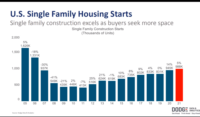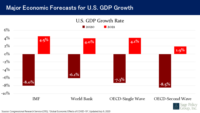Residential, Warehouse Construction Still Lead Recovery, Says Dodge Economist

As recovery continues, the US economy remains about 8% below where it was in February 2020, said Richard Branch, chief economist at Dodge Data & Analytics, citing impacts from rising COVID-19 cases, but total construction starts are expected to increase 7% in 2021.
“We’ve certainly made progress here,” said Branch, during the Dodge Construction Outlook- 3rd Quarter Update webinar Aug. 24. He points to stimulus packages and businesses reopening over the past several months, but “over the last several weeks, we’ve not made much progress as COVID cases rise again from the Delta variant.”
Not every region is in the same position, with economies in states such as Idaho, Montana, Nebraska and Rhode Island completely recovered while the Mid-Atlantic region lags behind the rest of the country.
In the residential sector, demand for single family homes remains “solid”, says Branch. The dollar value of starts in this category is poised to rise 9% in 2021, following a 14% increase in 2020.
However, “rising material prices are making entry level homes much harder to build, which is of course eating into demand,” said Branch, indicating that interest will began to wane among younger perspective home buyers, leading them back to multi-family housing.
“Demand for multi-family buildings has once again picked up,” said Branch. Dodge reports that starts are expected to rise 5% in 2021 after falling 1% last year.
In the non-residential sector, the dollar value of commercial starts is up 9%, following a sharp 20% decline in 2020. The majority of this growth continues to be spurred by warehouse construction. “I’ve run out of superlatives to discuss the warehouse market,” says Branch. “We’re looking at yet another smashed record in warehouse construction this year.”
Dodge expects both office and retail starts to grow a modest 4% in 2021, while hotel starts will continue to decline 18%. Manufacturing, however, is a “pleasant surprise” – starts are up 37% in 2021, after plummeting 58% last year.
Institutional construction is expected to rise 1%, with the largest sector, education, down 3%. Healthcare starts are forecast to increase 7%. “The healthcare sector has certainly seen its fair share of attention due to the COVID crisis,” Branch said, causing an increase in hospital construction that he expects to continue for years to come.
In the non-building sector, overall starts are up 5%, with environmental infrastructure and power and gas plants showing increases of 13% and 18%, respectively. Highways are down 2% while bridges increased 1%.
Branch noted that this forecast was not reliant on President Joe Biden’s infrastructure package, which is unlikely to have an impact until 2022.



.png?height=200&t=1680777472&width=200)

